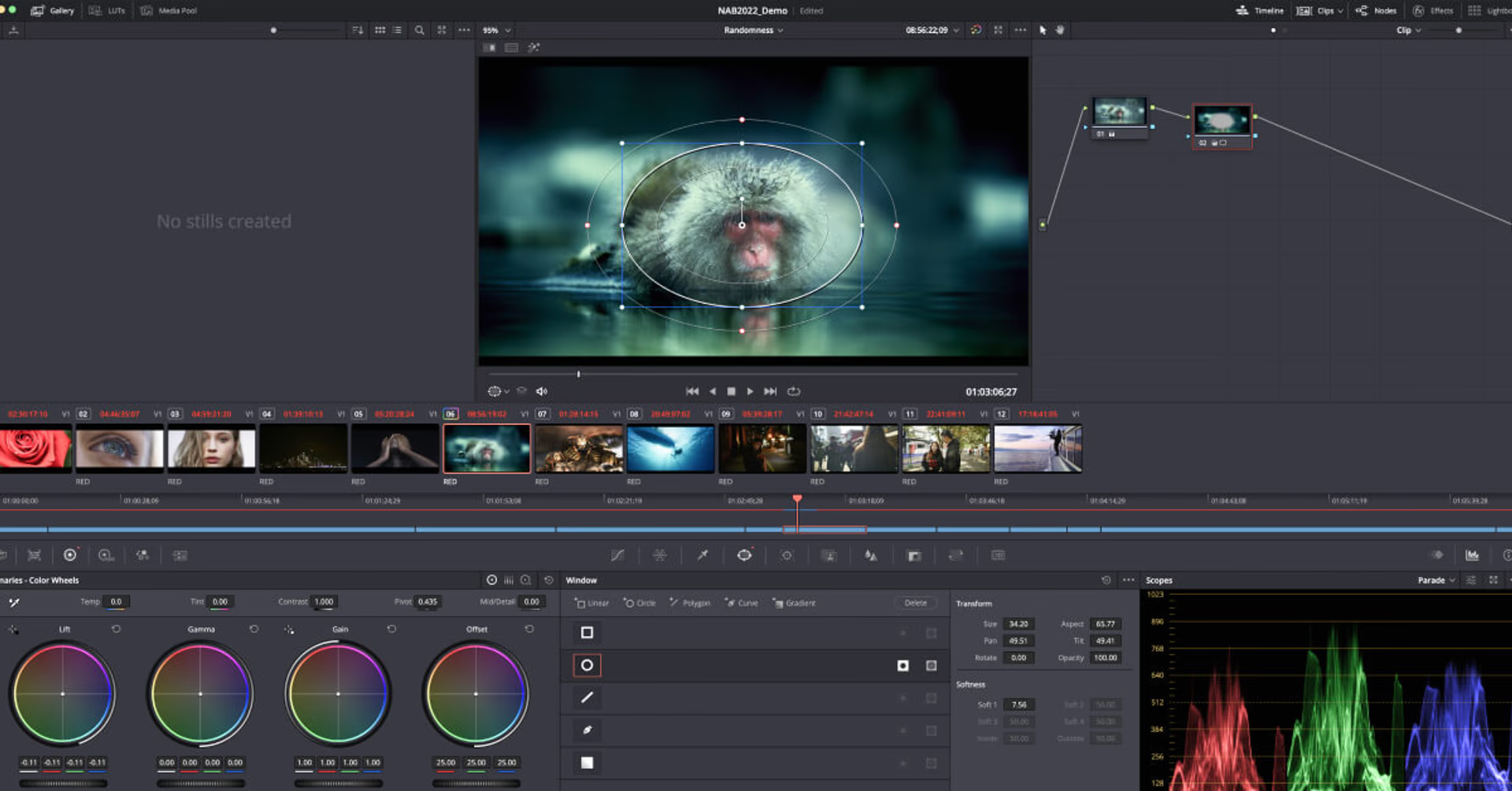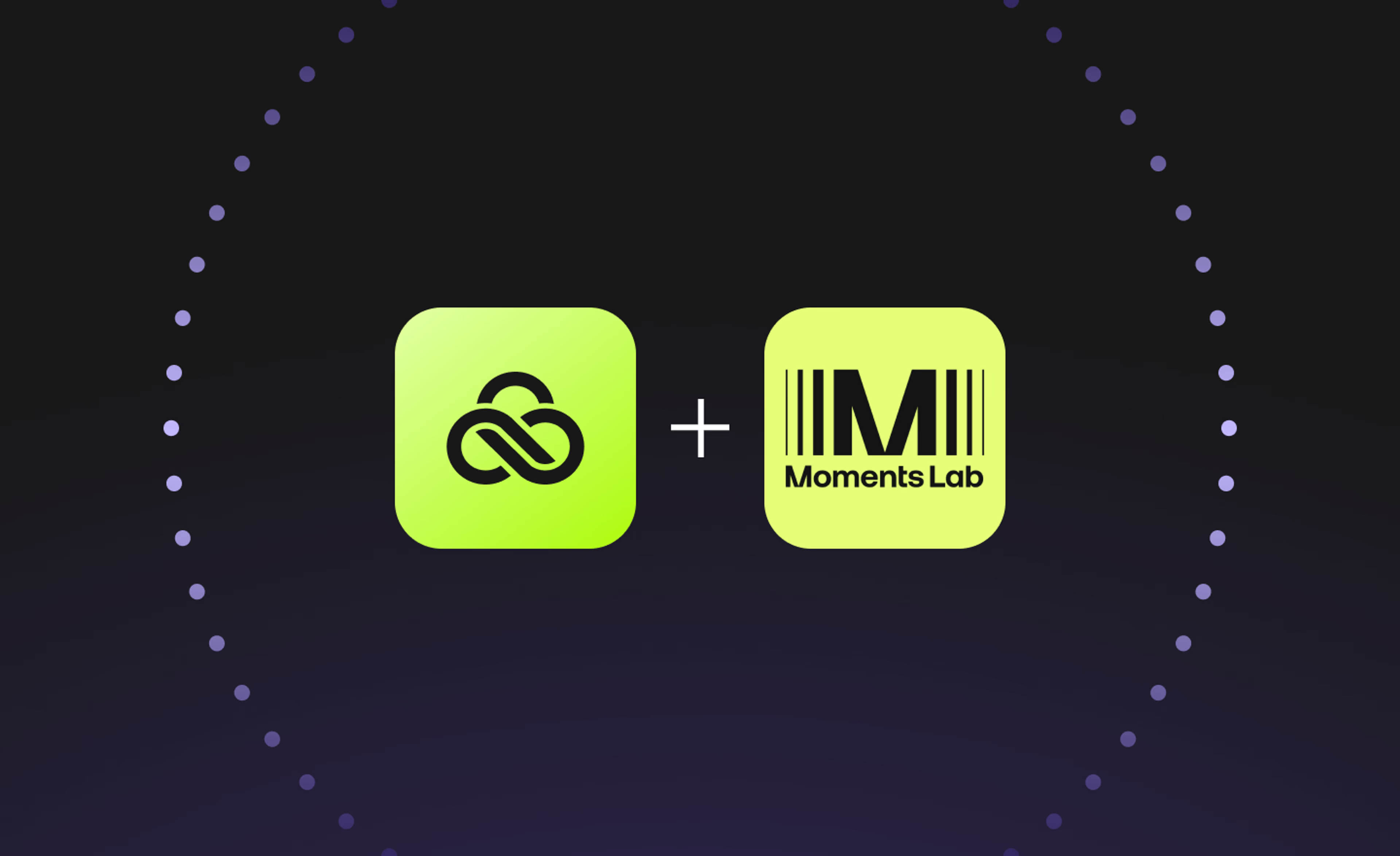Creative production
How to build a smooth video production workflow
April 2024
11 mins

Table of contents
- What is a video production workflow?
- How a defined video production workflow helps your team
- Key phases of a successful video production workflow
- Why video production workflows are moving to the cloud
- How LucidLink helps create non-linear cloud video production workflows
- 7 practical tips for building a smooth video production workflow
Your files, faster.
Access any file instantly, anywhere. Collaborate in real-time from one always-up-to-date, secure cloud filespace.
In an ideal world, you’d spend your days deep in the creative aspects of the video production process.
But, in reality, video production isn’t just about creating the content.
You also need to consider collaborators, budgets and deadlines – not to mention plenty of opinions. As a result, video production can sometimes feel like herding cats.
Creating a defined video production workflow helps bring order to video production chaos. With trusted processes and technology in place, you can deliver consistently brilliant creative. Even on the most hectic projects.
Read on for our need-to-know advice on how to create a smooth video production workflow.
We’ll cover production phases, challenges, tips, plus how cloud video workflows can help you turnaround better video content, faster.
What is a video production workflow?
A video production workflow is a repeatable set of steps that helps streamline your video projects, all the way from the creative brief, through to sign off and distribution.
With lots of moving parts, a defined video collaboration process helps you deliver high-quality video creative – whether it’s for TV, film, ads or social.
Your production workflow acts as a roadmap to keep your project on track. By establishing clear processes, tools and timelines for each stage of the production lifecycle, you can turn in quality content, on time, no matter what hurdles are thrown your way.
In the past, video production processes usually followed a linear, step-by-step approach. But, as we’ll explore in more detail shortly, non-linear cloud video editing is making video workflows a more collaborative affair.
First, let’s look at why creating a defined video workflow is well worth your time.
How a defined video production workflow helps your team
Process and structure aren’t priorities when you’re facing tight deadlines to deliver inspiring video creative.
But if you set up video workflows ahead of time, they’ll save you time, money and a lot of stress. Here’s why.
Manage budgets and deadlines
We all want to focus on creating great content. But most projects are tied to commercial goals.
The problem is, that when budgets and deadlines loom too heavily over video projects, it weighs on the creative process. Creating workflows that include the management of these administrative realities helps turn them into tickbox exercises, rather than creative drains.
Stay on task
Video projects involve multiple people and interweaving tasks. You can’t leave it up to chance that every task is on track.
If one cog in your video production workflow machine isn’t working, the knock-on effect can derail your entire project.
So, having a workflow that gives team members a clear understanding of their responsibilities, as well as providing visibility for team leads that things are going smoothly is essential. Project management tools like Asana, Monday and Adobe Workfront are good places to start.
Explore our recommended video collaboration tools here.
Collaborative freedom
Today’s creative teams often work from different locations. While hybrid or fully remote setups open up collaborative freedom, if there’s no defined workflow they can lead to errors, duplicated efforts and missed deadlines.
Well-defined video workflows provide an underlying structure to support streamlined collaboration – wherever you’re working from.
Creative focus
Whether it’s finding and downloading weighty media files, or jumping on another call, it can feel like you’re constantly being dragged away from the work that matters.
And once interrupted, it takes around 23 minutes to refind your focus. The implications of this go beyond current projects. Breaks in focus add up and start to impact deadlines, productivity and job satisfaction – just ask the team at VERSUS.
Sure, video workflows may not seem like the most exciting topic for creatives. But the right workflow will help minimize distractions so you can do your best work.
We’ve covered how a smooth video production workflow can help your team. Now let’s look at the steps involved and some of the common issues.
Key phases of a successful video production workflow
Today’s video creatives are often asked to wear many hats. You can cover the creative process all the way from editing and audio mixing, to motion graphics and color correction.
Although the size and complexity of video projects may vary, production generally encompasses the phases pre-production, production and post-production. We’ll also look at some of the nuances worth considering during the delivery stage.
Here’s an overview of each phase and the people involved, plus some common workflow challenges for video teams.
Pre-production

Pre-production is the starting point for all video or film projects. It’s where teams develop their ideas, as well as the plans to make their vision a reality.
During this stage, writers refine their scripts and teams meet to determine the resources and elements necessary to complete the project.
Pre-production encompasses a range of tasks, including scriptwriting, storyboarding, location scouting and pre-production meetings. It essentially covers all activities related to planning and preparation before filming begins.
For those in the growing virtual production space, pre-production is even more vital to ensure everything is set up and ready for a shorter shoot.
The creatives involved in the pre-production phase include:
Directors
Producers
Storyboard and concept artists
Writers
Post-production coordinators
LucidLink pre-production workflow tip
During production, teams need immediate access to footage and other production assets — and the ability to send videos without losing quality is critical. You’re also often dealing with high-resolution video formats that can take a long time to get into editors’ hands.
So one of the biggest challenges in pre-production is ensuring that all team members are on the same page, regardless of their location.
This means contributors need access to the latest versions of scripts, storyboards and other planning documents. In other words, pre-production teams need a single source of truth.
LucidLink’s shared filespace provides one place for all your project files. Using our cloud storage collaboration platform ensures that everyone’s working on the most current files and eliminates problems with syncing or duplicating efforts.
Production

Audiences can’t seem to get enough behind-the-scenes footage. Outtakes and video commentary have probably turned production into the most recognized phase.
This is where storyboards and scripts come to life and, fingers crossed, all the footage you need is captured in the production phase. For content producers and video professionals, the production stage represents the realization of the concept and serves as the foundation for the final product.
The creatives involved in this phase include:
Directors
Director of photography
Camera operators
Production and set designers
Production managers
LucidLink production workflow tip
During production, teams need immediate access to footage and other production assets. You’re also often dealing with high-resolution video formats that can take a long time to get into editors’ hands.
Limited access to content, or the inability to share footage quickly, not only delays production – it dims your team’s collaborative spark.
With LucidLink, all team members, whether on set, in the studio or editing video remotely can access files instantly. Even the largest files are available to work on from the get-go, streamed directly from the cloud. Now you can do production work like color grading and effects rendering, without the latency that typically comes with sending large files.
Getting real-time access and collaboration on files also bridges the gap between shooting and editing, so you can go from production to post-production in no time…
Post-production

Post-production is the final stage in the storytelling process.
But in reality, post teams are often involved from the start of a project, sharing advice on the best camera systems and formats for the project.
In post-production, raw footage is crafted into a final, cohesive piece. This phase may involve editing video, adding visual effects and graphics, mixing audio and color correction.
The creatives involved in this phase include:
Director/producer
Editors
Assistant editors
Visual effects (VFX) artists
Sound designers
Colorists
Music composers and sound editor
Audio engineers
Post-production coordinators
For a deeper dive, read our comprehensive guide on post-production workflows.
LucidLink post-production workflow tip
Post-production usually requires detailed collaboration across different specialties, including editors, sound engineers, colorists and VFX artists. Part of this involves iterative revisions and feedback cycles.
If you’re relying on traditional sync and share file systems, the upload or download process can take hours. In some cases, you might even resort to shipping hard drives. This approach is not only slow, but also prone to versioning problems during the feedback stage.
Post teams love LucidLink because they can work on the same projects simultaneously (and from their favorite creative tools) regardless of location. Instant access to files also makes the iterative process simpler, eliminating delays caused by sending files back and forth and waiting for downloads or uploads.
Delivery

You’ve run through your team’s feedback and polished your production. Now it’s time to share your work with stakeholders, whether they’re internal or external.
Once your video content is finalized, the last step is preparing files and assets for delivery. This is where content is packaged, archived and made accessible in different versions and formats.
In the past, the final cut may have been delivered via a hard copy or shared via a file transfer service.
LucidLink delivery workflow tip
Post-production usually requires detailed collaboration across different specialties, including editors, sound engineers, colorists and VFX artists. Managing an efficient VFX pipeline, along with the rest of post often involves iterative revisions and feedback cycles.
Physical media or vulnerable transfer methods can risk your work being leaked. Meanwhile unsecure file sharing spaces means your content can get into the wrong hands.
Don’t skip security during the delivery phase. LucidLink provides zero-knowledge encryption, centralized access management and SSO integration. That way your files remain completely secure, easily accessible by those you want to share them with, completely inaccessible to those you don’t.
Free resource
Tired of video chaos?
Discover strategies and tech to streamline collaboration and create headache-free workflows.

Why video production workflows are moving to the cloud
Earlier we mentioned that video workflows are shifting from linear to non linear.
This means that rather than waiting around for collaborators to finish and share their work, creators can work on video productions at the same time.
The jump to non-linear workflows is only being accelerated by the trends shaping the future of work. And while the move to more fully remote or hybrid productions is a resounding win for creatives, it has created new challenges in the video production workflow.
Not working in the same office, from the same hard drive, led to some repetitive and time-consuming workflow interruptions. We’ve already touched on many of these challenges during our look at the video production process –– including downloading, syncing, versioning and even shipping hard drives.
But embracing cloud technology and non-linear workflows can quickly solve these video production workflow issues.
Benefits of a non-linear cloud workflow:
Creators can work on video productions at the same time (and anywhere).
Creators can work at their own pace, reducing their reliance on others’ availability.
Teams can easily share, access, collaborate and review each other’s work.
Content producers can stop waiting around and get on with the creative work they love
Just imagine; a video editor in San Francisco can use LucidLink to edit visual effects, while an audio engineer in Lisbon is simultaneously editing audio in the same asset using Avid Pro Tools.
The result is faster and more creative video workflows in real-time, wherever teams are working.

How LucidLink helps create non-linear cloud video production workflows
Cloud-based workflows have quickly become essential for award-winning video teams everywhere.
These modern workflows offer unmatched flexibility and efficiency, from the first storyboard sketch to the final cut. In this fascinating behind the scenes webinar, the video production team from season three of the FX series “Atlanta” shared how cloud collaboration kept the program on track, even during the trickiest of shoots.
When the show’s plot moved overseas, they had to seamlessly integrate a European film crew with their US-based post-production team. On top of this, the team had to navigate the challenges of the pandemic, which pushed their US team to go fully remote.
In the past, collaboration under these circumstances would have been incredibly slow and complex. But using LucidLink, the team seamlessly shared media across geographies and timezones, just like they were together in the same office.
For another fix of workflow magic, here’s how the video production team behind The Bear used LucidLink to cook up the critically-acclaimed drama.
7 practical tips for building a smooth video production workflow
Let’s finish with some quick-fire practical tips you can apply to your video workflows.

1. Establish repeatable processes
Standardize your video workflow to ensure every project runs smoothly.
This includes setting clear naming conventions for files and folders. Consistent naming helps everyone on the team quickly locate and access files, cutting down on time wasted searching for project components. For example, you could use a naming convention that includes the project name, date and file type, like “ProjectName_Date_FileType”.
Project templates are also invaluable for speed and standardization. For instance, create a master project folder structure that includes subfolders for scripts, raw footage, edited versions, audio files and final outputs. Every new project starts with copying this template, ensuring consistent organization across all projects.
2. Designate a project manager
A dedicated project manager is crucial. This person manages timelines, coordinates team efforts and ensures all milestones are met.
Acting as the central point of communication, they address any issues and keep the project on track. Using project management tools helps streamline these tasks by providing real-time updates, visibility and easier collaboration.
3. Prioritize native integrations with creative tools
Integrate your workflow with the creative tools your team uses daily.
Native integrations can speed up the production process by automating routine tasks and enabling seamless data transfer. If you’re wondering – yes, LucidLink seamlessly integrates with the tools you use every day like Adobe Premiere Pro, After Effects, DaVinci Resolve and Avid Media Composer.
4. Use the power of the cloud
As we’ve covered, cloud technology can improve your workflows in numerous ways. That includes working together from anywhere, but also fast performance, lower maintenance costs and robust scalability. Read more about the benefits of the cloud here.
5. Have a single source of truth
You need a single source of truth throughout your video production workflow. For planning, collaboration and then as a place to keep your final video assets. Remember final means final!
For example, if finalized assets need to be replaced due to glitches or newer versions are created, the previous final asset is deleted and replaced by the updated copy in the same location.
6. Keep your content secure
You’ve spent days on your work, keep it safe! Ensure your workflow includes comprehensive security measures such as encrypted storage and secure access controls. This protects your creative assets throughout the production process.
7. Back up your projects
Always back up your projects. It's a best practice in workflows to have a backup stored in a separate location to prevent data loss. Regularly backing up files ensures that, in the event of a hardware failure or data corruption, your work remains safe and recoverable.
Implementing a robust backup strategy can save your team from potential setbacks and ensure continuity.
Follow these tips and you'll create a smoother, more secure video production workflow. This will not only streamline your creative process, but boost the quality of your final product – ensuring your team consistently delivers top-notch video content.
Want to see what cloud-based video production workflows can do for your team? Try LucidLink for free today.
FAQs
A non-linear workflow lets video teams work on different parts of a project at the same time, without waiting for one task to finish before starting another. It’s a faster, more flexible way to edit — especially when paired with cloud tools that enable real-time collaboration.
Cloud storage gives video teams instant access to media files from anywhere, cutting out the tedious cycle of downloads, uploads and relinking. Tools like LucidLink take it further, letting editors, VFX artists and sound designers work on the same files in real time.
Video workflows provide structure to complex projects, helping creative teams stay organized, hit deadlines and avoid version chaos. A clear workflow lets editors focus on storytelling instead of chasing files or fixing miscommunications.
Absolutely. With the right tools, video editors can collaborate on the same files from anywhere. Platforms like LucidLink stream media directly from the cloud, so teams can edit, review and deliver high-res projects without file transfers slowing them down.
A typical video workflow includes pre-production (planning), production (filming) and post-production (editing, VFX, audio mixing). Cloud-based workflows streamline these phases by letting teams collaborate across locations without the usual bottlenecks.
For fast, seamless collaboration, cloud-native platforms like LucidLink are ideal. They let teams access and edit large video files instantly, without downloads. For simpler handoffs, file transfer services like MASV or WeTransfer also work, but with more steps involved.
Keep reading

Creative production
Unlocking the potential of your media library with AI and real-time access
Explore how AI and real-time access make your media library searchable, actionable and ready for faster, smarter storytelling.
16 December 2025, 5 mins read

Creative production
How to build a creative workflow that really flows
Discover how to build a seamless creative workflow using practical strategies and tools. Get tips for collaboration and creative project management.
26 November 2025, 17 mins read

Creative production
Sports video editing: the complete guide for sports highlights and video editing
Learn how to create pro-level sports highlight videos with the best sports video editing software. Tips, tools and real-world workflows included.
20 November 2025, 7 mins read
Join our newsletter
Get all our latest news and creative tips
Want the details? Read our Privacy Policy. Not loving our emails?
Unsubscribe anytime or drop us a note at support@lucidlink.com.